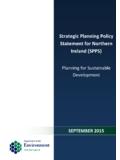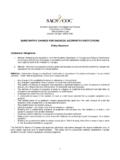Transcription of National Planning Policy Framework
1 National Planning Policy FrameworkJuly 2018 Ministry of Housing, Communities and Local GovernmentCm 9680 National Planning Policy Framework Presented to Parliament by the Secretary of State for Ministry of Housing, Communities and Local Government by Command of Her Majesty July 2018 Crown copyright 2018 This publication is licensed under the terms of the Open Government Licence except where otherwise stated. To view this licence, visit Where we have identified any third party copyright information you will need to obtain permission from the copyright holders concerned. This publication is available at Any enquiries regarding this publication should be sent to us at Ministry of Housing, Communities and Local Government, Fry Building, 2 Marsham Street, London, SW1P 4DF or complete the form at ISBN 978-1-5286-0745-2 CCS0718182968 07/18 Printed on paper containing 75% recycled fibre content minimum Printed in the UK by the APS Group on behalf of the Controller of Her Majesty s Stationery Office 3 Contents 1.
2 Introduction 4 2. Achieving sustainable development 5 3. Plan-making 8 4. Decision-making 13 5. Delivering a sufficient supply of homes 17 6. Building a strong, competitive economy 23 7. Ensuring the vitality of town centres 25 8. Promoting healthy and safe communities 27 9. Promoting sustainable transport 30 10. Supporting high quality communications 33 11. Making effective use of land 35 12. Achieving well-designed places 38 13. Protecting Green Belt land 40 14. Meeting the challenge of climate change, flooding and coastal change 44 15. Conserving and enhancing the natural environment 49 16. Conserving and enhancing the historic environment 54 17.
3 Facilitating the sustainable use of minerals 58 Annex 1: Implementation 62 Annex 2: Glossary 64 4 1. Introduction 1. The National Planning Policy Framework sets out the Government s Planning policies for England and how these should be applied1. It provides a Framework within which locally-prepared plans for housing and other development can be produced. 2. Planning law requires that applications for Planning permission be determined in accordance with the development plan2, unless material considerations indicate otherwise3. The National Planning Policy Framework must be taken into account in preparing the development plan, and is a material consideration in Planning decisions.
4 Planning policies and decisions must also reflect relevant international obligations and statutory requirements. 3. The Framework should be read as a whole (including its footnotes and annexes). General references to Planning policies in the Framework should be applied in a way that is appropriate to the type of plan being produced, taking into account Policy on plan-making in chapter 3. 4. The Framework should be read in conjunction with the Government s Planning Policy for traveller sites, and its Planning Policy for waste. When preparing plans or making decisions on applications for these types of development, regard should also be had to the policies in this Framework , where relevant.
5 5. The Framework does not contain specific policies for nationally significant infrastructure projects. These are determined in accordance with the decision-making Framework in the Planning Act 2008 (as amended) and relevant National Policy statements for major infrastructure, as well as any other matters that are relevant (which may include the National Planning Policy Framework ). National Policy statements form part of the overall Framework of National Planning Policy , and may be a material consideration in preparing plans and making decisions on Planning applications. 6. Other statements of government Policy may be material when preparing plans or deciding applications, such as relevant Written Ministerial Statements and endorsed recommendations of the National Infrastructure Commission.
6 1 This document replaces the first National Planning Policy Framework published in March 2012. 2 This includes local and neighbourhood plans that have been brought into force and any spatial development strategies produced by combined authorities or elected Mayors (see glossary). 3 Section 38(6) of the Planning and Compulsory Purchase Act 2004 and section 70(2) of the Town and Country Planning Act 1990. 5 2. Achieving sustainable development 7. The purpose of the Planning system is to contribute to the achievement of sustainable development. At a very high level, the objective of sustainable development can be summarised as meeting the needs of the present without compromising the ability of future generations to meet their own needs4.
7 8. Achieving sustainable development means that the Planning system has three overarching objectives, which are interdependent and need to be pursued in mutually supportive ways (so that opportunities can be taken to secure net gains across each of the different objectives): a) an economic objective to help build a strong, responsive and competitive economy, by ensuring that sufficient land of the right types is available in the right places and at the right time to support growth, innovation and improved productivity; and by identifying and coordinating the provision of infrastructure; b) a social objective to support strong, vibrant and healthy communities, by ensuring that a sufficient number and range of homes can be provided to meet the needs of present and future generations; and by fostering a well-designed and safe built environment, with accessible services and open spaces that reflect current and future needs and support communities health, social and cultural well-being; and c) an environmental objective to contribute to protecting and enhancing our natural, built and historic environment.
8 Including making effective use of land, helping to improve biodiversity, using natural resources prudently, minimising waste and pollution, and mitigating and adapting to climate change, including moving to a low carbon economy. 9. These objectives should be delivered through the preparation and implementation of plans and the application of the policies in this Framework ; they are not criteria against which every decision can or should be judged. Planning policies and decisions should play an active role in guiding development towards sustainable solutions, but in doing so should take local circumstances into account, to reflect the character, needs and opportunities of each area.
9 10. So that sustainable development is pursued in a positive way, at the heart of the Framework is a presumption in favour of sustainable development (paragraph 11). 4 Resolution 42/187 of the United Nations General Assembly. 6 The presumption in favour of sustainable development 11. Plans and decisions should apply a presumption in favour of sustainable development. For plan-making this means that: a) plans should positively seek opportunities to meet the development needs of their area, and be sufficiently flexible to adapt to rapid change; b) strategic policies should, as a minimum, provide for objectively assessed needs for housing and other uses, as well as any needs that cannot be met within neighbouring areas5, unless: i.
10 The application of policies in this Framework that protect areas or assets of particular importance provides a strong reason for restricting the overall scale, type or distribution of development in the plan area6; or ii. any adverse impacts of doing so would significantly and demonstrably outweigh the benefits, when assessed against the policies in this Framework taken as a whole. For decision-taking this means: c) approving development proposals that accord with an up-to-date development plan without delay; or d) where there are no relevant development plan policies, or the policies which are most important for determining the application are out-of-date7, granting permission unless: i.

















